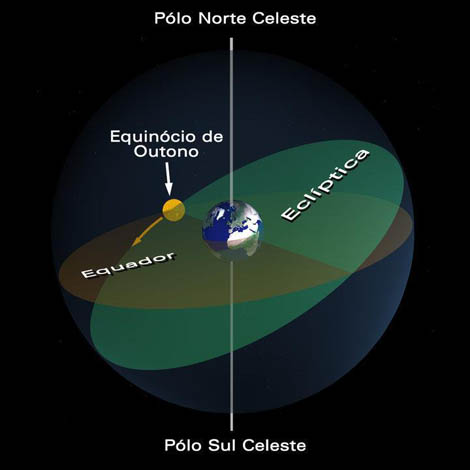 At around 15:49, Lisbon time, on 22 September, our planet reached one of the two moments in its trajectory around the Sun, in which its rays will strike perpendicularly on the equator.
At around 15:49, Lisbon time, on 22 September, our planet reached one of the two moments in its trajectory around the Sun, in which its rays will strike perpendicularly on the equator.
This astronomical moment is known as the equinox and corresponds to the beginning of the northern hemisphere autumn season. This lasts for 89,81 days until the next Winter Solstice which occurs, this year, on December 21st at 11:12 am.
The word equinox comes from the Latin words aequus (equal) and nox (night), that is, it means equal nights. In other words, it refers to the time when day and night have the same duration, ie 12 hours. This happens when the apparent motion of the Sun to an observer on Earth crosses the plane that results from the projection of the Earth's equator onto the celestial horizon.
Over the course of an Earth year, this happens twice in each hemisphere: in early autumn and early spring. These seasons occur inversely in each hemisphere: the beginning of autumn in the northern hemisphere coincides with the beginning of spring in the southern hemisphere and vice versa.
For the same hemisphere, in our case, the north, the two equinoxes occur exactly on opposite sides of the Earth's orbit around the Sun. However, the dates on which they happen do not divide the year into equal parts! They don't always occur on the same day every year. But let's go by parts.
The Autumn Equinox occurs 186 days after the Spring Equinox that precedes it, and this is 179,25 days after the previous Autumn.
Why this difference? Because the Earth's orbit around the Sun is elliptical, as we've known since 1609 thanks to Kepler, and because the Earth is closer to the Sun (perihelion) in the first days of January.
 It so happens that this closer proximity to the Sun makes the Earth's angular velocity between autumn and spring the highest in its entire orbit and, as predicted by Kepler's 2nd law, it moves faster in “ direction” to the Spring equinox than when approaching the Autumn equinox, after passing the point where our planet is furthest from the Sun, the aphelion, in early July.
It so happens that this closer proximity to the Sun makes the Earth's angular velocity between autumn and spring the highest in its entire orbit and, as predicted by Kepler's 2nd law, it moves faster in “ direction” to the Spring equinox than when approaching the Autumn equinox, after passing the point where our planet is furthest from the Sun, the aphelion, in early July.
It is as if the Earth is now idly sprawling before entering the more difficult times that are now coming.
The fact that the average time period between the beginning of two autumn (or spring) equinoxes is 365,25 days, ie about 6 hours longer than a common year (365 days), makes the autumn of a given year starts 6 hours later than the autumn of the previous common year (actually the difference is closer to 5h55m).
After 3 years, there is an advance of about 18 hours. However, the correctness of the calendar introduced by the leap year produces an apparent correction of 6 hours. For this and other reasons mentioned above, the day on which the autumnal equinox occurs varies every two years between the 22nd and 23rd of September.
 From the beginning of autumn, the nights will be progressively longer than the day until the beginning of winter. The progressive decrease in the period of time that the Sun is above the horizon, will make living beings adjust to withstand ever lower temperatures and light intensities.
From the beginning of autumn, the nights will be progressively longer than the day until the beginning of winter. The progressive decrease in the period of time that the Sun is above the horizon, will make living beings adjust to withstand ever lower temperatures and light intensities.
Deciduous trees and other plants divest their leaves. They gather their photosynthetic arsenal and, with the removal of the chlorophylls that dressed them in green in spring and summer, other pigments now stand out in reddish, orange, brownish, yellowish colors, which paint the landscape with a dazzling autumnal symphony.
In fact, the equinoxes are moments of pure astronomical poetry to which life has adapted with its best melodic variations.
Antonio Piedade
Science in the Regional Press – Ciência Viva


















Comments